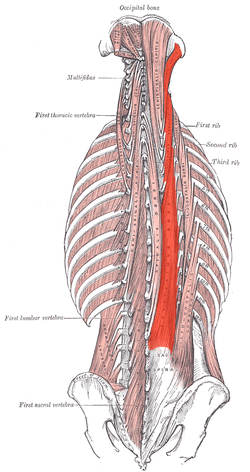Longissimus Thoracis: Difference between revisions
Oyemi Sillo (talk | contribs) No edit summary |
No edit summary |
||
| (10 intermediate revisions by 5 users not shown) | |||
| Line 5: | Line 5: | ||
</div> | </div> | ||
== Description == | == Description == | ||
[[Image:250px-Longissimus.png|longissimus thoracis|alt=|thumb]]The [[longissimus]] muscle is a long intrinsic [[Back Muscles|muscle of the back]]. Along with [[spinalis]] and [[Iliocostalis Thoracis|iliocostalis]], these three muscles comprise the [[Erector Spinae|erector spinae group.]] <ref name=":0">Ken Hub Longissimus Available: https://www.kenhub.com/en/library/anatomy/longissimus-muscle<nowiki/>(accessed 5.2.2022)</ref> It is divided into three parts ([[Longissimus Capitis|capitis]], cervicis, thoracis) based on their superior attachments and location. The erector spinae muscles, including longissimus, are the most powerful extensors of the vertebral column<ref name=":0" />. | |||
== Origin == | |||
The common broad, thick tendon with Iliocostalis Lumborum, fibers from the transverse and mamillary processes of the lumbar vertebrae and lumbrosacral aponeurosis<ref name="p2">http://www.wheelessonline.com/ortho/longissimus_thoracis_1</ref> | |||
The common broad, thick tendon with Iliocostalis Lumborum, fibers from the transverse and mamillary processes of the lumbar vertebrae and lumbrosacral aponeurosis<ref name=" | |||
== Insertion == | == Insertion == | ||
The tips of transverse process of all thoracic vertebrae and the lower 9 or 10 ribs between the tubercles and angles <ref name=" | The tips of transverse process of all thoracic vertebrae and the lower 9 or 10 ribs between the tubercles and angles <ref name="p2" /> | ||
== Nerve Supply == | == Nerve Supply == | ||
Dorsal rami of thoracic and lumbar spinal nerves (T7 to L5) <ref name=" | Dorsal rami of thoracic and lumbar spinal nerves (T7 to L5) <ref name="p3">http://www.anatomyexpert.com/app/structure/5230/</ref> | ||
== Blood Supply == | == Blood Supply == | ||
Dorsal branches of the posterior intercostal arteries from the thoracic aorta. <ref name=" | Dorsal branches of the posterior intercostal arteries from the thoracic aorta. <ref name="p3" /> | ||
== Action == | == Action == | ||
[[File:Lower back extension.jpeg|thumb]] | |||
Acting | |||
* | * unilaterally, extension of vertebral column and flexion to the same side | ||
* | * bilaterally, extension and hyperextension of vertebral column<ref name="p2" /> | ||
== Function == | |||
< | <span style="line-height: 1.5em;">Draws ribs down to help with breathing<ref name="p3" /> </span> | ||
== | == References == | ||
< | <references /> | ||
[[Category:Anatomy]][[Category:Muscles]][[Category:Lumbar Spine - Anatomy]] [[Category:Lumbar Spine - Muscles]] [[Category:Lumbar Spine]] | |||
Latest revision as of 07:05, 5 February 2022
Original Editor - Oyemi Sillo
Lead Editors - Oyemi Sillo, Kim Jackson, Lucinda hampton, WikiSysop and 127.0.0.1
Description[edit | edit source]
The longissimus muscle is a long intrinsic muscle of the back. Along with spinalis and iliocostalis, these three muscles comprise the erector spinae group. [1] It is divided into three parts (capitis, cervicis, thoracis) based on their superior attachments and location. The erector spinae muscles, including longissimus, are the most powerful extensors of the vertebral column[1].
Origin[edit | edit source]
The common broad, thick tendon with Iliocostalis Lumborum, fibers from the transverse and mamillary processes of the lumbar vertebrae and lumbrosacral aponeurosis[2]
Insertion[edit | edit source]
The tips of transverse process of all thoracic vertebrae and the lower 9 or 10 ribs between the tubercles and angles [2]
Nerve Supply[edit | edit source]
Dorsal rami of thoracic and lumbar spinal nerves (T7 to L5) [3]
Blood Supply[edit | edit source]
Dorsal branches of the posterior intercostal arteries from the thoracic aorta. [3]
Action[edit | edit source]
Acting
- unilaterally, extension of vertebral column and flexion to the same side
- bilaterally, extension and hyperextension of vertebral column[2]
Function[edit | edit source]
Draws ribs down to help with breathing[3]
References[edit | edit source]
- ↑ 1.0 1.1 Ken Hub Longissimus Available: https://www.kenhub.com/en/library/anatomy/longissimus-muscle(accessed 5.2.2022)
- ↑ 2.0 2.1 2.2 http://www.wheelessonline.com/ortho/longissimus_thoracis_1
- ↑ 3.0 3.1 3.2 http://www.anatomyexpert.com/app/structure/5230/








